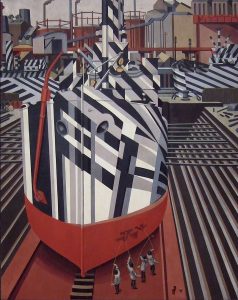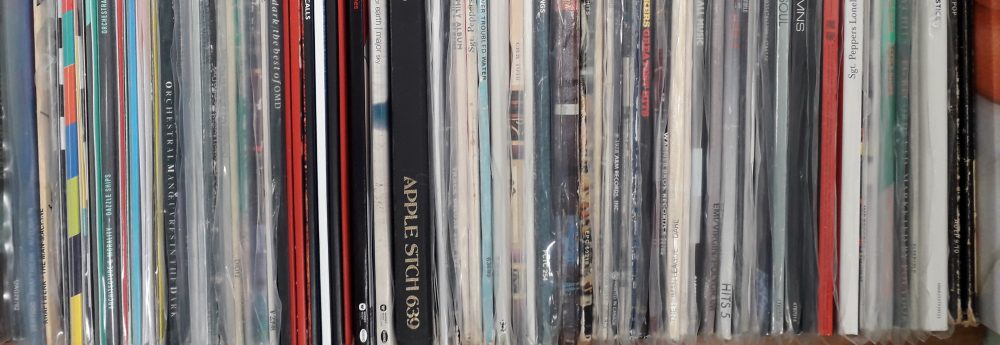What links camouflage and an experimental album from 1983? Read on and all will be explained, faster than the breeze over stormy seas…

Dazzle-ships in Dry Dock in Liverpool
Dazzle camouflage was invented during World War I by Norman Wilkinson. It’s contrasting colours and shapes are not meant to work as traditional camouflage and make the ship ‘fade’ into the background; instead, dazzle camouflage makes it hard to determine the speed, heading and range of a ship, making it harder to attack. So what has all this got to do with my exhibition?
Edward Wadsworth spent some of the War painting dazzle camouflage onto ships and afterwards, created the painting Dazzle-ships in Dry Dock in Liverpool in 1919. Peter Saville saw the painting and used it as inspiration for the sleeve of Orchestral Manouevres in the Dark’s fourth album, Dazzle Ships.
Dazzle Ships is one of those strange albums that seems to have managed to rehabilitate itself and has become considered something of a classic, a far cry from the less than complementary reviews it received on release; one writer described Genetic Engineering as prissy and twee and Time Zones as ‘pointlessly mundane’. Another describes Dazzle Ships as ‘half-baked, pseudo-intellectual ballast’. Ouch! I think we can agree that critics and the public at the time found it somewhat ‘challenging’. It sold just 300,000 copies on release, compared to 3 million copies of Architecture and Morality, OMD’s previous album. The singles, Genetic Engineering (with fantastic photography from Trevor Key on the sleeve) and Telegraph, peaked at 20 and 42 respectively. The track intended to be the third single, Radio Waves, was never released. It seems the sound collages might have proved too much for some: the title track Dazzleships (parts II, III and VII)* consists of samples arranged to give the impression of ships at war, Time Zones samples speaking clocks from around the world and Radio Prague is the call sign of, unsurprisingly, Radio Prague.
Since then, it’s been voted 25th in the top 100 albums of 1983 in Slicing Up Eyeballs reader vote, as well as being cited as influences on bands such as Saint Etienne and Death Cab for Cutie.
The album, or any of the tracks from it would fit perfectly into the theme of my exhibition. If you want to contribute a memory related to any of the tracks, you can do so through the link on the homepage. It could just be a sentence or it could be longer, but I’d love to know why it’s special to you.
I love Dazzle Ships in all it’s slightly off the wall glory and I shall certainly be ‘dancing to some geo-political tunes’ tonight during Tim’s Twitter Listening Party and loving every minute!
*Dazzleships parts I, IV, V and VI was an audio visual installation in the Edmund Gardner pilot ship at the Museum of Liverpool in 2014 and 2015, and was a collaboration between OMD and National Museums Liverpool.
